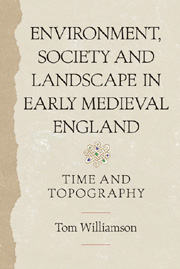Book contents
- Frontmatter
- Contents
- List of Illustrations
- Acknowledgements
- Introduction
- 1 Settlement and Society
- 2 Nature's Frame
- 3 Culture, Ethnicity and Topography
- 4 Small Shires, Deep Roots
- 5 The Gradient of Freedom
- 6 Two Countrysides?
- 7 Village, Farm and Field
- 8 Landscape and Settlement
- 9 Woodland and Pasture
- Conclusion: Time and Topography
- Bibliography
- Index
- ANGLO-SAXON STUDIES
3 - Culture, Ethnicity and Topography
Published online by Cambridge University Press: 05 April 2013
- Frontmatter
- Contents
- List of Illustrations
- Acknowledgements
- Introduction
- 1 Settlement and Society
- 2 Nature's Frame
- 3 Culture, Ethnicity and Topography
- 4 Small Shires, Deep Roots
- 5 The Gradient of Freedom
- 6 Two Countrysides?
- 7 Village, Farm and Field
- 8 Landscape and Settlement
- 9 Woodland and Pasture
- Conclusion: Time and Topography
- Bibliography
- Index
- ANGLO-SAXON STUDIES
Summary
The term ‘settlement’ has a useful ambiguity in early-medieval studies, being used not only as a term for the location and morphology of villages, hamlets and farms, the subjects of subsequent chapters, but also to describe the immigration of new peoples – the Anglo-Saxons and the Danes – into England. Major debates surround the character and scale of both of these settlements, as noted in Chapter 1, but as yet little attempt has been made to examine either within a geographical or environmental context. This, in essence, is the purpose of the present chapter.
Archaeology and ethnicity
As discussed briefly in Chapter 1, the precise significance of the new, intrusive material culture of the fifth and sixth centuries – especially the cemeteries featuring cremations or inhumations with grave goods – remains contested, with some archaeologists, most notably Anthony and Harke, arguing that it indicates a fully fledged folk movement, while other insist that it reflects a take-over by a small warrior elite. It is useful to set this diversity of opinion against the more general development of archaeological interpretation over the last half century or so. In the nineteenth and early twentieth centuries material culture was usually viewed as a direct reflection of ethnicity, and the cemeteries and other intrusive material could thus be interpreted in a relatively straightforward way as reflecting the events recorded in the early historical sources – in Gildas, Bede and the Anglo-Saxon Chronicle. The cemeteries were the signature of Germanic invaders and settlers.
- Type
- Chapter
- Information
- Environment, Society and Landscape in Early Medieval EnglandTime and Topography, pp. 61 - 81Publisher: Boydell & BrewerPrint publication year: 2012



